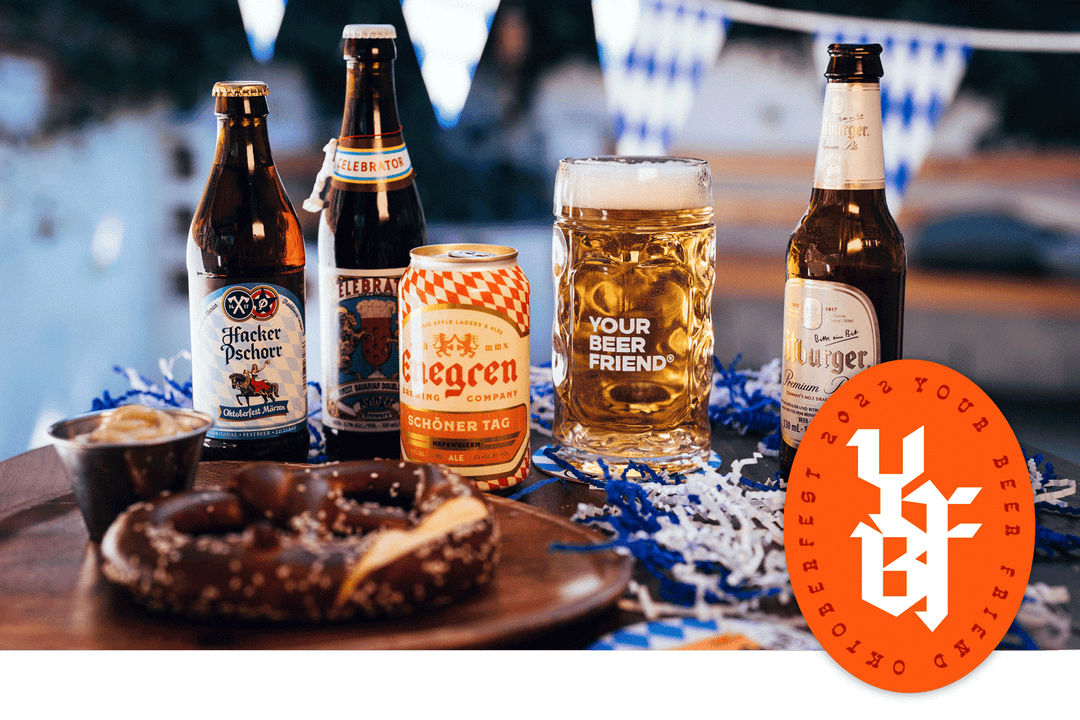What is Beer Made Of?

So... What is Beer Made Of?
Beer is made of hops, malted barley, yeast, and water. Those are the four main ingredients in every beer. We're done! Everyone can go home.
We can so easily answer the question because of an old German beer purity law called the Reinheitsgebot (or The Bavaria Law of 1516). If you would like to learn more about the law, you can read up from an earlier blog post - Where Does Beer Come From?
A short summary of that law is that Beer can only contain four ingredients - barley, hops, water, and yeast.
All four ingredients are going to impact flavor, aroma, mouthfeel, and appearance of the beer. Where beer styles really get their uniqueness is the type of barley used, the varietal of hop, the species of yeast, and the composition of the water being used. If the brewer wants to make chocolatey, roasty, toasty stout. They are going to be using a barley that has been roasted to get those flavors. Brewer wants to make a super dank, grapefruit IPA? Different hops give you different flavors (some being dank and grapefruity!)
Besides these four main ingredients brewers have the option to brew with other ingredients as well. A few of the more common ingredients used are honey, fruit, cacoa nibs, coffee beans, etc the list goes on. Besides those ingredients just listed a brewer can technically use whatever they want to make a beer. They want to make a car tire flavored beer? Sure go ahead and throw a car tire in there. Would that beer taste good (or even be safe to drink?) probably not, but I'd still try it!
Deep Dive on Malted Barley:
Malted barley is barley (a cereal grain) that has been allowed to germinate by soaking in water. By soaking the barley in water you are preparing the starches in the barley so that later on they will be ready to be turned into fermentable sugars. After germination, next up is the kiln. This is where we are going to roast our barley.
The Maltsters
A fancy term for the people in charge of malting the barley - the maltsters will put the barley in a kiln (which is a giant fancy oven) and slowly raise the temperature to a minimum of 120° Fahrenheit then they will increase that temperature if they desire more 'roast' on the barley. Raising the temperature is going to bring out different flavors. At one end of the spectrum you have the very lightly toasted barley that is going to be way more subtle, and just have general notes of bread, crackers, lightly sweet, etc.. On the other end of that spectrum is the fully burnt max temperature barley that really is more like burnt toast, deep chocolate, coffee notes. In between those two extremes you're going to run into a wide variety of barleys, all that are just every so slightly different from the previous iteration, you can caramel, toffee, bread, etc.. Besides all the different flavors that the kilning process is going to be adding, it's also going to be dictating the color of the beer. If you use more roasted barley in your beer, your beer is going to come out darker in color because the barley was basically burnt. So color in beer is directly correlated to the how 'roasted' the barley is.
Another reason the roasting process is so important is because it's going to stop the sprouting of the barley and start to dry the grain. At this point when the barley is dried out it'll be chalk full of sugars, starches, and a special enzyme - diastase.
Diastase is important because it is the enzyme that is going to be turning all of those starches that we have available in the barley and turning them into maltose (simple sugars). Why it's important to have those simple sugars around is because later in the beer making process we are going to adding yeast into the beer and yeast can't digest complex sugars, so we make sure it has plenty of simple sugars around so it can do its thing.
Note: From this point on, I'll use the term malt - for barley. Malt is the cereal grain that has gone through the malting process. So this includes barley, but can also mean wheat, rye, oats, rice, corn, etc..
Now the malt is ready to be used by the brewer! The brewer is going to build their grain bill, meaning picking the malt they want to use for the beer. There are 2 main things to consider when building your malt bill
- how much alcohol do you want in your beer?
- What flavors are you trying to accomplish with this beer?
More malt means more sugar which is going to mean more alcohol later down the road.
As I previously said, different types of malt are going to give you different flavors in your beer. Not only does the roast matter on the grain you're using but the type of grain will impact the beer. Rye, wheats, and oats are all going to impact the beer in mouthfeel, taste, aroma, clarity of the beer, and a lot of other aspects. It’s really up to the brewer to understand how all these grains work and what makes a good beer.
So What Are Hops?
Hops are the green cone-shaped flowers that grow on the plant Humulus lupulus. They grow all around the world with the most notable places being Germany, Czech Republic, New Zealand, and North America. They thrive in moderate climates with rich soil and plenty of sunshine. They are infamously hard to grow, taking up to three years to fully mature as plants and still requiring a lot of manual labor to harvest the plant. They grow on what is called a bine - yes bine with a b, not a typo. The difference between a bine and a vine is that a vine will use tendrils, or suckers, to cling onto a supporting pole, while a bine will wrap it's stem in a helix around a supporting pole.
They have a few key roles as far as making beer goes. A quick breakdown is that hops will provide bitterness, flavor, and aroma. Hops will also act as a natural preservative, helping your beer last longer on the shelf.
Like other plants, there are different hop varietals. Some of the more well known hop varietals are Citra, El Dorado, Mosaic, Simcoe, Galaxy, Cascade, and really the list goes on, and on, and on. These different hop varietals all have different properties and characteristics that make them unique. Common flavor and aroma notes from hops are citrus, pine, tropical fruits, dank, grapefruit, grassy, floral, spicy, earthy, etc..
In addition to flavor and aroma notes hops are adding to the beer, they are also going to be adding bitterness into your beer through the addition of alpha acids. Different hops will have different levels of alpha acids, therefore brewers tend to group hops into two main groups, bittering hops and aroma hops. Bittering hops are going to be hops that are high in alpha acids, thus providing more bitterness when used. Aroma hops are going to be lower on the bitterness scale, so when used are going to be mainly contributing to the aroma of the beer.
For one of our favorite hoppy beers check out our rundown on Beyond Repair
Hops are so versatile they can be even be used in cider. Here's a little glimpse into a Dry Hopped Cider from Modern Times
All Things Yeast:
What is beer made of has been pretty simple up to this point, mainly because we've talked about two very tangible things hops and malt. Yeast is where it starts to get a little less tangible. Yeast is a microorganism, it's a living and breathing thing, and (if you're on Earth) it's going to be floating in the air all around you. Yeasts job in the beer making process is to eat sugars (that we get from our malted barley) and then turn those sugars into CO2, "flavor", and alcohol (thank god for yeast because it makes booze for us).
Just like we discussed with hops and malt, there are different types of yeast. Beer yeast stems from the yeast genos (fancy way of saying group really) called Saccharomyces. Within this group there is Saccharomyces cerevisiae and Saccharomyces pastorianus. These refer to top (cerevisiae) and bottom (pastorianus) fermenting. If you want to learn more about the differences between the two check out this article Ale vs Lager it explains the differences between top and bottom fermenting yeast strains.
For the purpose of discussing what is beer made of, we're just going to stick to the basics and try and nail down what yeast, generally, does in beer. Yeast creates C02, flavor, and alcohol.
Yeast does this by literally eating up those simple sugars and metabolizing them. This process is called fermentation and typically takes between 2 - 6 weeks to fully ferment.
C02:
We as humans like our carbonation, so we love that yeast puts it right into the beer for us. Nowadays most breweries will actually off gas most the carbonation produced during the fermentation, and then force carbonate later. But the yeast is still doing it's thing and producing the C02.
Flavor:
Yeast will create flavor as a by product when consuming those sugars. There are a ton of different flavors that yeast can make, a few are bananas, clove, barnyard (or horse blanket), nail polish remover (gross!). These flavors come in the form of esters and phenols. Esters and phenols are chemical compounds that impact flavor. So even though you're tasting bananas, that's just the chemical compound of banana flavor.
Alcohol:
Yeast creates alcohol! Technically yeast creates ethanol and other fusel alcohols. Ethanol is the more technical term for what we call alcohol. Yeast also creates other fusel alcohols which can give off floral or wine like aromas as well.
That's what yeast does in beer in a nutshell.
Water . . . I Swear It Matters
The most obvious, but most overlooked ingredient in beer… water. Malt and hops are typically the most discussed beer ingredients with yeast being the one most talked about with weirdo beer geeks (I can get away with saying this because I am one of those weirdo beer geeks). Water is typically left out of the conversation. Why is that? Between us… it's because water is kind of boring to talk about. When we talk about water in beer we're really talking about pH balance, sulfide to chloride ratio, hard vs soft water, and other potential 'contaminants'. All of these elements are going to influence the beer in a multitude of ways. They will add to flavor, affect mouthfeel, promote yeast health, help to highlight hop bitterness, promote sweet malty finish, etc.
Even though water in beer is a little boring, it's arguably the most important ingredient in beer. Beer is made up of roughly 85%-95% water.
In fact, it's so important that historically beer styles were shaped around the water that was local to the area. Pilsner is a great example of this, the water in the region is soft water with low sulfate and carbonate content. This water profile helped define the Czech-style pilsner.




